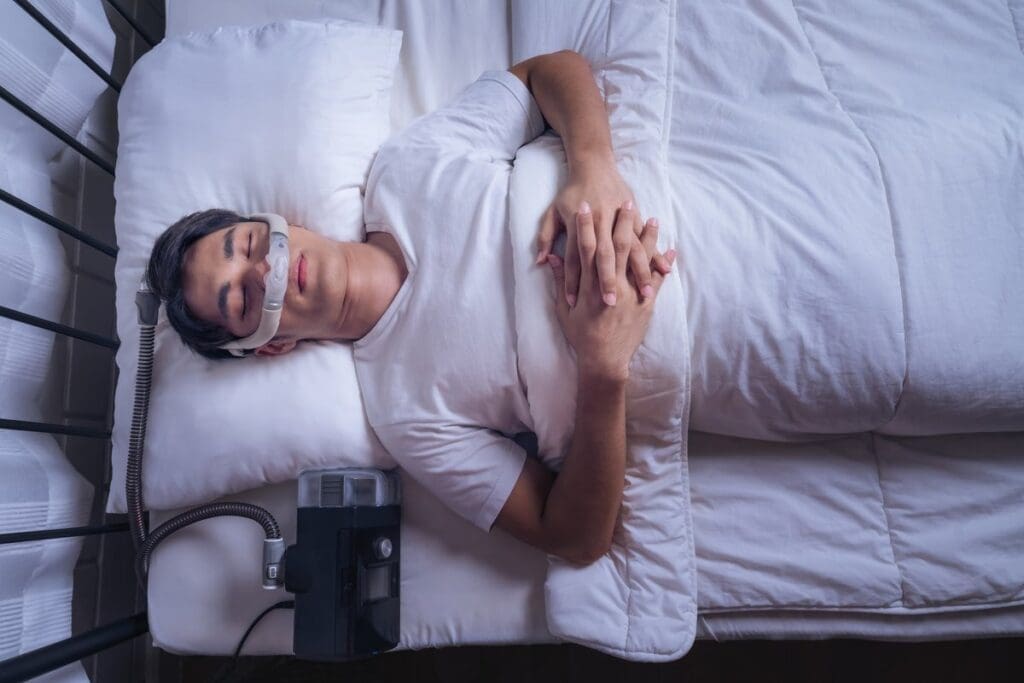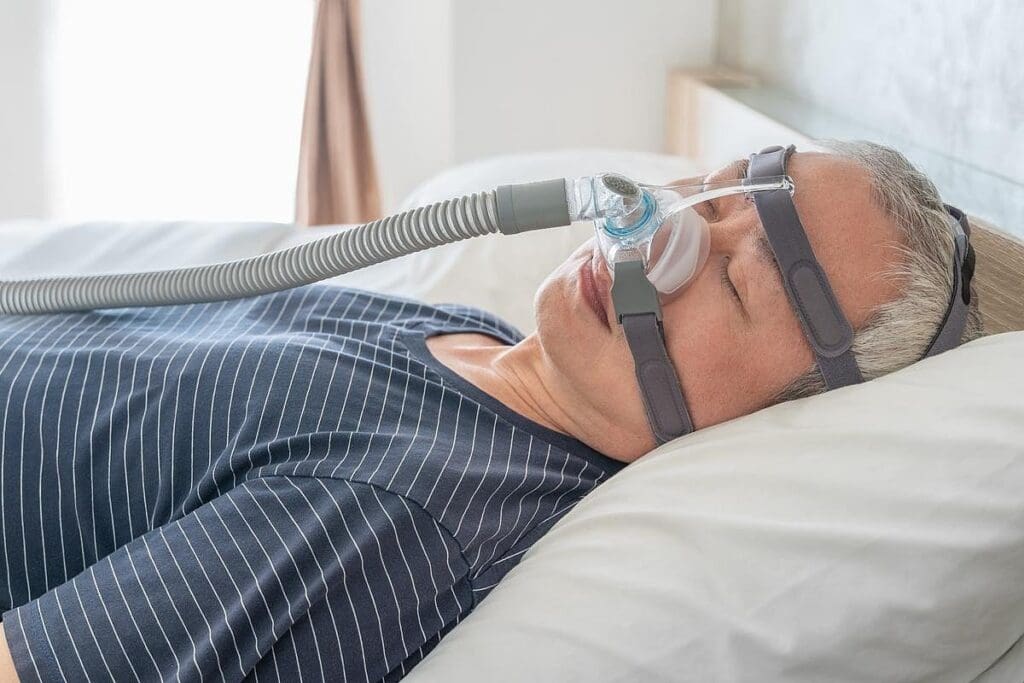Last Updated on November 24, 2025 by
Obstructive sleep apnea (OSA) is a serious condition that affects life expectancy. Studies have found a link between OSA and a shorter life span. This is mainly because OSA is connected to heart disease, stroke, and diabetes. Many patients wonder how long can someone live on a bipap machine, as it is a common treatment to help manage breathing difficulties caused by OSA and related conditions.

The connection between sleep apnea life expectancy and death rates is complex. It’s important for both patients and doctors to understand the risks of OSA. This knowledge helps in managing the condition better.
Recognizing how OSA impacts life expectancy, sleep apnea is key. People can then get medical help early. This could lead to better health outcomes.
Many people don’t realize the dangers of obstructive sleep apnea until it’s too late. This sleep disorder causes breathing to stop and start many times during sleep. It leads to poor sleep and low blood oxygen levels.
When someone has sleep apnea, their airway can block, stopping breathing. This happens many times at night. It disrupts sleep and stresses the body. It can also harm the heart and lead to serious health issues.
OSA quietly harms the body by causing inflammation and stress on the heart. If left untreated, it can increase the risk of death by 4.3 times compared to those without it. These effects can shorten life and lower overall health.
It’s important to know about OSA’s risks to get it treated early. Treating sleep apnea can prevent its harmful effects and improve life quality.
Sleep apnea’s impact on death rates is clear. It’s not just a sleep issue; it’s a serious threat to life.
Research shows people with severe OSA face a 4.3 times higher risk of death. This highlights the need to diagnose and treat OSA quickly.

An 18-year study found big differences in death rates. About 19% of those with severe OSA died, compared to 4% without. This shows how untreated OSA can be deadly.
Studies also found a 74% increased risk of death from any cause with OSA. This shows how vital it is to manage sleep apnea to lower death risks.
It’s key for doctors and patients to understand these numbers. They show why diagnosing and treating OSA is so important to lower death rates.
It’s important to know how OSA severity affects life expectancy. Obstructive Sleep Apnea (OSA) is divided into three levels: mild, moderate, and severe. Each level affects life expectancy differently.
Mild OSA might seem less severe, but it’s a big risk. People with mild OSA have a 40% increased mortality risk compared to those without it. This shows that mild OSA should not be ignored.
Moderate OSA causes more sleep disruption and oxygen loss. Those with moderate OSA face a 70% higher death risk than those without OSA. This highlights the need for early treatment.
Severe OSA has the biggest sleep disruptions and oxygen loss. It leads to a 280% greater mortality risk. This shows how critical it is to manage severe OSA well to live longer.
The severity of OSA directly affects life expectancy. More severe cases mean higher risks. Knowing these risks helps both patients and doctors manage OSA better and possibly live longer.
It’s important to know the dangers of sleep apnea. If not treated, it can cause serious health problems. These problems can even lead to death.
People with untreated sleep apnea face a higher risk of breathing pauses during sleep. These pauses can cause sudden death. They happen when the airway gets blocked, disrupting sleep and lowering blood oxygen levels.
Timely treatment, like CPAP therapy, can help. It can lower the risk of these dangerous pauses.
Those with Obstructive Sleep Apnea (OSA) face a higher risk of death. This is due to heart disease, stroke, and other health issues. The severity of OSA increases the risk of these fatal outcomes.
Knowing the risks and getting treatment can help. It’s key for OSA patients to work with their healthcare team. This way, they can manage their condition well.
Treating sleep apnea can greatly reduce the risk of death. It’s a step towards better health and safety.
BiPAP therapy is a top choice for treating sleep apnea. It helps patients live longer and better. By keeping airways open, BiPAP machines stop sleep apnea episodes. This improves sleep and lowers health risks.
BiPAP is great for those with severe sleep apnea or who can’t use CPAP. It manages sleep apnea well. This can add years to a patient’s life. Research shows it also improves heart health and lowers stroke risk.
BiPAP and CPAP both treat sleep apnea, but differently. BiPAP has two pressure settings, making it more comfortable for some. Both can increase survival chances, but the right choice depends on the patient’s needs.
BiPAP therapy works best with patient compliance and good health. Sticking to the treatment plan leads to better results. Regular check-ups with doctors also help keep therapy effective.
A BiPAP machine’s life depends on use, care, and tech updates. A well-kept machine usually lasts 3 to 5 years. New tech might require updates or new machines for best performance.
In summary, BiPAP therapy is a good option for sleep apnea. It can extend life and improve the quality of life. Knowing the benefits and what affects BiPAP therapy helps patients choose wisely.
Untreated sleep apnea can cut life expectancy short. But treatment can make a big difference. The gap in life expectancy between treated and untreated patients is huge. This shows how critical it is to diagnose and treat sleep apnea.
Untreated sleep apnea raises the risk of death a lot. Research finds that severe OSA can increase death risk by 4.3 times compared to those without it. The death rate for severe OSA can reach 19% over 18 years, versus 4% for mild or no OSA.
CPAP therapy is a common treatment for sleep apnea. It keeps the airway open during sleep, boosting survival chances. Studies show CPAP can cut all-cause mortality risk by 74% in severe OSA patients. A study found, “CPAP therapy can significantly improve survival rates in patients with obstructive sleep apnea.”
“The use of CPAP therapy has been shown to not only improve the quality of life but also to extend the lifespan of individuals with sleep apnea.”
CPAP is very effective, but other treatments like oral appliances and lifestyle changes help too. Oral appliances work for mild to moderate OSA. Lifestyle changes, like losing weight and exercising, can also help manage symptoms and survival.
Sticking to treatment is key for sleep apnea patients. Using CPAP or other treatments as directed can greatly improve survival. It’s vital for patients to team up with their healthcare team for the best treatment results.
In summary, sleep apnea’s impact on life expectancy depends on treatment. CPAP therapy, in particular, can significantly boost survival rates. This underlines the need for early diagnosis and sticking to treatment plans.
Many risk factors can affect the life expectancy of those with obstructive sleep apnea. Knowing these factors is key to better management and survival.
Age is a big factor in sleep apnea life expectancy. Older people with sleep apnea face a higher risk of death. This is because they have less physical strength and often have other health issues. Studies show that the risk of dying from sleep apnea goes up after 60.
Having other health problems like high blood pressure, diabetes, and heart disease makes sleep apnea worse. These conditions can make sleep apnea’s effects more severe, raising the risk of death.
Lifestyle choices like being overweight, smoking, and not being active can also harm sleep apnea life expectancy. Losing weight, stopping smoking, and staying active can help reduce some risks of sleep apnea.
By tackling these risk factors, people with sleep apnea can live longer and better lives.
Knowing how sleep apnea affects life expectancy is key. Untreated sleep apnea can cut life short. But, getting treatment early can help you live longer.
Using BiPAP therapy is a good start. It helps lower risks from sleep apnea. This way, you can live a better life, free from heart disease.
It’s important to follow your treatment plan and make healthy lifestyle changes. This can help you live longer and feel better. With the right care, people with sleep apnea can enjoy a healthier life.
Getting treated for sleep apnea can greatly improve your life expectancy. So, don’t ignore the symptoms and seek medical help right away.
CPAP machines usually last 3 to 5 years. This depends on how much you use it and what the maker says.
Life expectancy with sleep apnea varies. It depends on how bad the condition is and if it’s treated. Untreated severe sleep apnea can greatly shorten life.
Sleep apnea raises the risk of death. Studies show people with untreated severe sleep apnea are up to 4.3 times more likely to die from any cause.
Yes, sleep apnea can be deadly if not treated or managed well. It increases the risk of heart disease, stroke, and other serious conditions.
The risk of dying from sleep apnea depends on its severity. Severe, untreated sleep apnea significantly raises the risk of death.
With treatment like CPAP, life expectancy for sleep apnea patients can be much better. It can be close to that of the general population.
Untreated sleep apnea, and severe cases in particular, can shorten life. This is due to higher risks of heart disease, stroke, and other serious issues.
While rare, sleep apnea can cause death during sleep. This usually happens due to heart or breathing problems.
The average age of death for someone with sleep apnea varies a lot. It depends on how severe the condition is, any other health issues, and if it’s treated.
The severity of sleep apnea directly affects life expectancy. Mild, moderate, and severe cases are linked to higher mortality risks.
Untreated severe sleep apnea is linked to a higher death rate. About 19% of people with severe sleep apnea died in an 18-year study.
Sticking to treatment, like CPAP, greatly improves survival chances for sleep apnea patients. This shows how important consistent treatment is.
Subscribe to our e-newsletter to stay informed about the latest innovations in the world of health and exclusive offers!